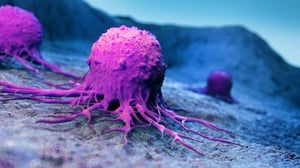The chemotherapy of the future could be administered through nanometre particles (i.e. particles the size of billionths of a meter) and heated by magnetic fields.
And for what purpose? To greatly increase the effectiveness of these cancer drugs.
If chemotherapy drugs are “loaded” on to tiny metal particles sensitive to magnetic fields, and if these fields are then activated to induce the particles themselves to generate heat, there is up to a 34% higher chance that the drugs will destroy the cancer cells compared to the results achieved by those without added heat.
This is, at least, what researchers from University College London have discovered. Results of their work were published in the Journal of Materials Chemistry B (a scientific journal of the Royal Society of Chemistry).
“Nanoparticle induced hypothermia has been considered as a promising approach for cancer treatment for decades”, says the researchers. However, the use of this technique has remained limited to only a few types of tumours (in particular, to brain tumours, such as fast-growing glioblastomas). “Yet – the researchers continue – this system has extraordinary potential worth pursuing for new clinical applications”.
In the case of the experiment conducted at University College London, the researchers used iron oxide nanoparticles and coated them with a molecule (a polymer) sensitive to both heat and the degree of acidity of the tumour. As a result of these characteristics and using other special techniques, the nanoparticles were able to enter the cancer cells. When the oncologists then activated the magnetic field, the nanoparticles produced heat and, only at that point, the polymer coating released a chemotherapeutic called doxorubicin (which had been previously inserted by the researchers).
The researchers discovered that only mild heating was required. Cancer cells usually die at 42 degrees Celsius (compared to healthy ones at 45 degrees). But it is enough to reach 40 degrees to start to see the enhancement of the effectiveness of the chemotherapy. The method works when the nanoparticles are absorbed within the diseased cell, but also (in a milder form) when they remain on the surface of the cell. An easier target to reach because tumours are often difficult to penetrate.
The experiments were performed in the laboratory, with prostate, breast and glioblastoma cancer cells. Given the good results, new tests will be performed on animals and then, if the positive results are confirmed, will be applied to humans.
“This therapy”, explained Nyugen TK Thanh, the main author of the study, “also has potential to reduce the side effects of chemotherapy, by ensuring it is more highly-targeted on cancer cells rather than healthy tissue”.
This occurs, we add, also because the polymer coating prevents the chemotherapy drug from seeping into healthy tissue.
However, this aspect will need to be explored in further pre-clinical tests. Olivier Sandre, from the University of Bordeaux, co-author of the study, confirms: “Since heat can be generated through the alternating magnetic field, the release of the drug can be highly localised to cancer cells, potentially reducing side effects.”

